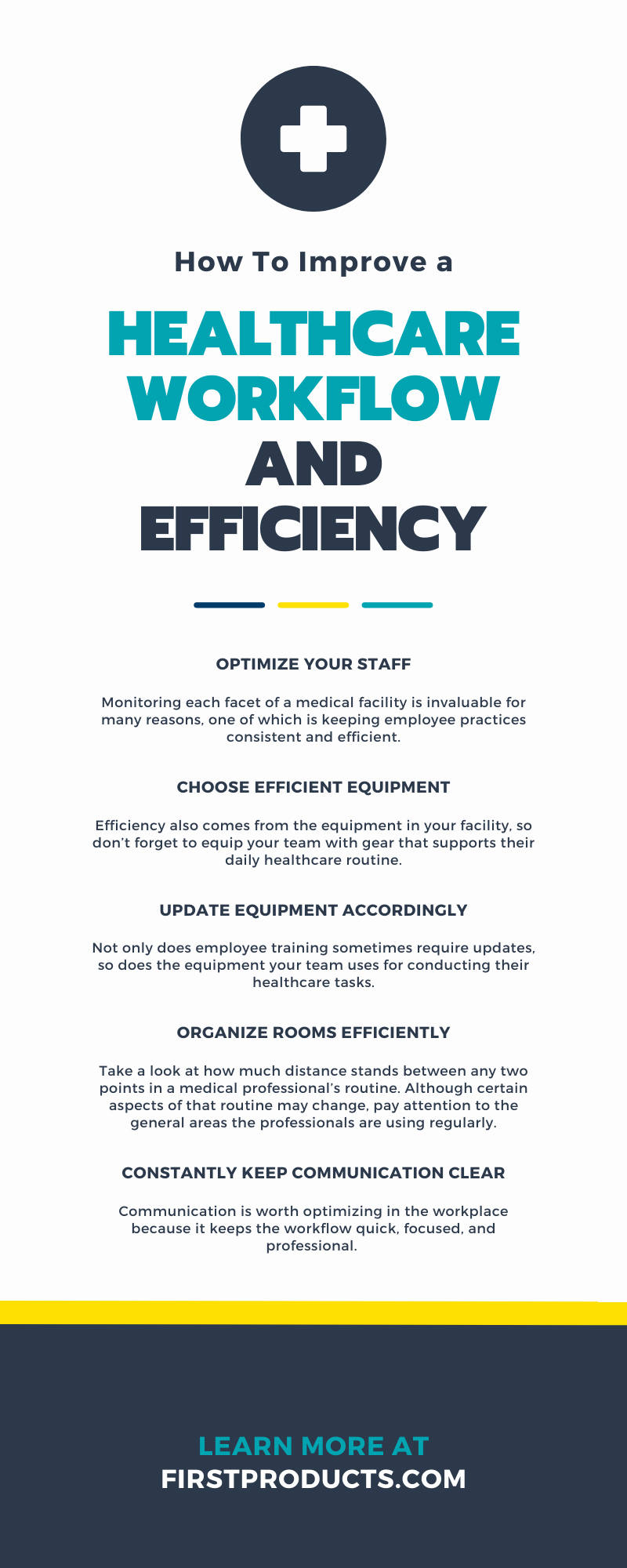How To Improve a Healthcare Workflow and Efficiency
Sep 19th 2022
Healthcare facilities are home to a lot of work and a lot of patients, which requires a staff who can serve them all successfully. Like many workplaces, unforeseen hiccups can appear in a healthcare facility that hinders efficiency, which is an issue when someone’s health is on the line.
While the health of your patients is serious, it’s important to remember that you shouldn’t stress about improving productivity. The best changes don’t always require ample work. View these ideas for how to improve a healthcare workflow and efficiency so that you can give your patients the attention, care, the medical treatments they deserve.
Optimize Your Staff
Monitoring each facet of a medical facility is invaluable for many reasons, one of which is keeping employee practices consistent and efficient. If you discover that certain departments in the building are causing workflow to slow down, take a careful look at the employee training and how the team uses that training every day. Does the staff stray from any training practices after the course is complete? Is the training course itself outdated or otherwise ineffective?
If you find that your staff needs new training to promote productive practices, then waste no time setting up a new program to accommodate. For instance, if your staff uses inefficient maintenance procedures for machines, then it’s time to upgrade those procedures. The sooner you can teach efficient practices to your staff, the sooner those practices will influence workflow.
Improving overall workflow also requires a staff that is knowledgeable in what they’re doing, so be sure that you only hire team members who can keep up with your workflow. They must use the proper practices every day. This doesn’t mean that your staff doesn’t have room for improvement, but it means that they should all work toward completing daily tasks to the best of their abilities. A straightforward step like hiring the right staff can be the key ingredient to a better work environment.
Choose Efficient Equipment
Efficiency also comes from the equipment in your facility, so don’t forget to equip your team with gear that supports their daily healthcare routine. For example, our mobile medical carts at First Products ensure your staff can take their workstation with them when traversing the building. No longer will they need to walk back and forth around the facility constantly Moreover, you can ensure a more productive workflow by looking at the battery design.
When your mobile carts have hot-swappable batteries, it means that staff can swap out the batteries without shutting down the machine. Thus, downtime reduces significantly. Anytime you’re shopping for equipment to install in your facility, always speak with your manufacturer about the most efficient design solutions. If they offer custom designs, don’t hesitate to explore your options to learn just how precisely you can match the machine to your medical facility.
Update Equipment Accordingly
When talking about optimizing staff, we briefly touched on the importance of monitoring and assessing your workflow consistently to find inefficiencies. Not only does employee training sometimes require updates, so does the equipment your team uses for conducting their healthcare tasks. This is why it helps to stay up to date with current medical technology relevant to your facility. You can evolve your workplace with the industry around you.
For instance, if one piece of equipment has a significantly more downtime than other machines, explore ways you can reduce that downtime with modern models. Even updating your computers with faster, more powerful features may help your workflow run better. At the end of the day, it all comes down to the results of your workplace monitoring and how you want to make the necessary changes. Before you make any changes just yet, let’s explore more helpful ways you can boost workflow and efficiency effectively.
Organize Rooms Efficiently
Speaking of necessary changes, one shift you should consider in the workplace is the physical location of certain areas. Simply put, take a look at how much distance stands between any two points in a medical professional’s routine. Although certain aspects of that routine may change, pay attention to the general areas the professionals are using regularly.
The time it takes to move around a medical facility is critical to optimize because, in many cases, someone’s health is on the line. Efficiency in professional healthcare facilities isn’t just about speed, it’s about using that speed to better help the patients who visit regularly. Even if it’s just moving areas together to help staff more efficiently communicate with one another, you can make a substantial impact on productivity by implementing a new facility layout. So, what big changes can you make to your building now?
Constantly Keep Communication Clear
Communication is worth optimizing in the workplace because it keeps the workflow quick, focused, and professional. This is another factor to look at when assessing productivity because if communication slows down in one particular department, it’s time to take a closer look to see how you can improve the pace. If a patient needs immediate attention for an injury, illness, etc., then the workflow in your facility needs to move in a way to ensure that announcement swiftly reaches the professionals who can help.
These changes don’t always have to be massive for them to have a big impact. For example, simply having a meeting to discuss the importance of quickly relaying information verbally, through email, and other relevant means may be the push your staff needs to move quicker. That said, location, equipment efficiency, and more factors can also influence communication. If there is a communications breakdown in your facility, get to the bottom of it as soon as possible so that you can bring consistency and clarity back to your workflow.
The importance of day-to-day communication also makes staff feedback even more valuable. Inquiring your staff about any concerns or feedback they have regarding workflow efficiency, including communication, can make it much easier to pinpoint where the problem in the pipeline is. Once you pinpoint the issue, you can start brainstorming, solving problems, and creating a harmonious workplace. By learning how to improve a healthcare workflow and efficiency, you’ve already taken the right first step.

